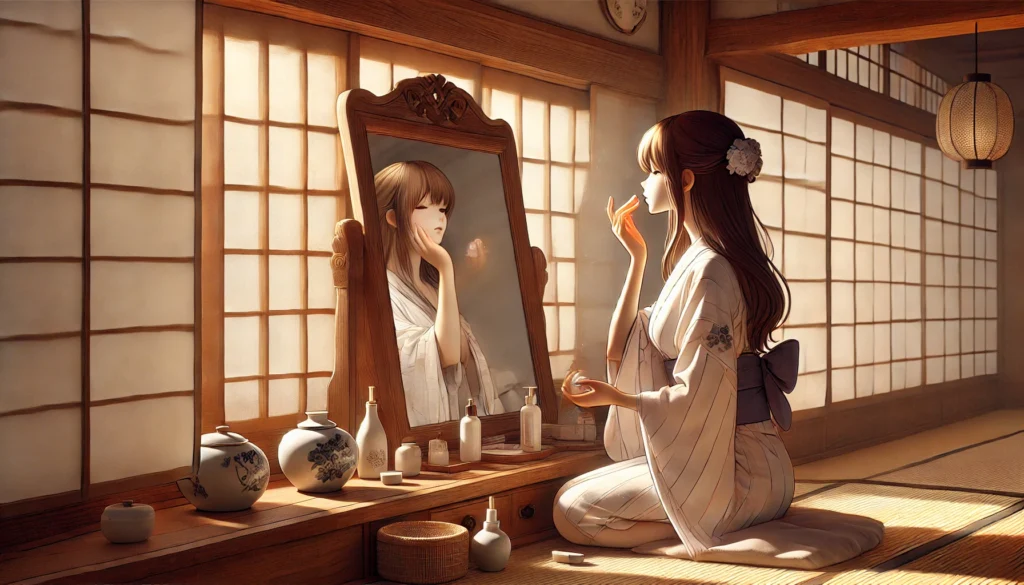In a world where beauty standards continuously evolve, Japan stands out with its distinct aesthetic ideals that blend centuries-old traditions with contemporary influences. Understanding female beauty standards in Japan offers fascinating insights into the cultural values, historical contexts, and social dynamics that shape perceptions of attractiveness in this unique island nation.
The Historical Evolution of Beauty Standards in Japan
Japanese beauty ideals have transformed dramatically throughout history, reflecting changes in society, culture, and foreign influences. Traditional concepts of beauty in Japan were deeply rooted in values of modesty, elegance, and natural grace.
During the Heian period (794-1185), aristocratic women prized pale skin, perfectly oval faces, and long, straight black hair. The classic beauty exemplified in The Tale of Genji described noble women with faces shaped like eggs, small mouths, and teeth blackened with ohaguro (a practice of dyeing teeth black that continued until the Meiji era).
As Japan moved through different historical eras, beauty standards evolved while maintaining certain core elements. The geisha tradition, which reached its peak during the Edo period (1603-1868), created an iconic image of Japanese beauty with white-painted faces, red-accented lips, and elaborate hairstyles that continues to influence modern aesthetics.
Eight Key Elements of Contemporary Female Beauty Standards in Japan
1. The Significance of Pale, Unblemished Skin
Perhaps the most enduring female beauty standard in Japan is the preference for fair, flawless skin. Unlike Western cultures where tanned skin is often associated with health and vitality, Japanese beauty ideals have long favored porcelain-like complexions.
This preference has deep historical roots. In feudal Japan, pale skin signified nobility and wealth, as it indicated a life spent indoors rather than working in the fields under the sun. Today, this cultural preference manifests in Japan’s enormous skincare industry, with products promising whitening, brightening, and blemish-free results dominating the market.
The commitment to skin protection is visible in everyday Japanese life. During summer months, it’s common to see women fully covered with UV-protective clothing, wearing gloves, carrying parasols, and sporting wide-brimmed visors—all to shield their skin from the sun’s darkening effects.
As I observed in my visit to Japan’s southern islands, described in our Exploring the Japanese Nansei Islands post, this beauty standard persists even in tropical regions, though perhaps with less intensity than in metropolitan areas.
2. Facial Structure: The Small, Slim Face Ideal
Another prominent beauty standard in Japan is the preference for small, slim faces with delicate features. The term “小顔” (kogao, meaning “small face”) appears frequently in beauty magazines and advertisements.
A petite face with a narrow jawline, small chin, and high cheekbones is widely considered attractive. This standard is so prevalent that specialized massage techniques, facial exercises, and even tools designed to “slim” the face have become popular in Japan’s beauty market.
The desire for smaller facial proportions has made procedures that reduce the appearance of jaw muscles (masseter reduction) among the most requested cosmetic treatments in Japan.
3. The Double Eyelid Aesthetic
Eye appearance plays a crucial role in Japanese beauty standards, with double eyelids (二重, futae) being particularly prized. While approximately 50% of Japanese people naturally have a visible crease in their upper eyelids, those without this feature often seek ways to create the appearance of double eyelids.
Double eyelids are valued because they make the eyes appear larger and more expressive—qualities associated with youth and femininity in Japan. This has led to the popularity of temporary double eyelid products like specialized glue, tape, and fiber solutions, as well as permanent surgical procedures.
The desire for wider, rounder eyes reflects both traditional Japanese beauty ideals and possible Western influences on contemporary standards. However, it’s important to note that the Japanese aesthetic typically favors a natural-looking double eyelid rather than dramatically large eyes.
4. Nose Structure and Proportion
The high-bridged nose (鼻が高い, hana ga takai) is another facial feature considered beautiful in Japan. While Western beauty standards might focus on nose size or shape, Japanese aesthetics often emphasize the height of the nose bridge.
A nose with a higher bridge is seen as providing better facial balance and creating a more three-dimensional profile. This preference stands in interesting contrast to some Western contexts where nose reduction is a common cosmetic procedure.
The appreciation for higher nose bridges highlights how beauty standards in Japan can differ significantly from Western ideals while still being influenced by concepts of facial harmony and proportion.
5. Body Type Preferences: Slender and Petite
When it comes to body image, Japanese beauty standards generally favor slim, petite figures. The cultural ideal emphasizes slenderness rather than curves, with a particular focus on overall slightness rather than specific proportions.
This preference is reflected in Japan’s fashion industry, where clothing is typically designed for smaller frames, and in media representations of beauty that predominantly feature slim women. The average clothing size in Japan runs smaller than in many Western countries, and plus-size options remain limited despite growing diversity in body acceptance.
However, as noted in our “Climate and Seasons in Japan” article, regional differences exist across the country. In some areas, particularly among younger generations, there’s growing appreciation for the “bon-kyu-bon” (ボン・キュ・ボン) silhouette—a term describing an hourglass figure with pronounced bust and hips balanced by a small waist.
6. The Importance of Long, Slender Legs
Despite the general preference for petite figures, longer legs are widely considered attractive in Japan. This element of Japanese beauty standards is particularly evident in fashion, where styles that emphasize leg length—such as high-waisted skirts, shorts, and strategic hemlines—are perennially popular.
The appreciation for long legs transcends seasons, with many Japanese women continuing to wear leg-revealing styles even during colder months, often paired with tights or stockings. This trend speaks to the significant value placed on this particular aspect of physical appearance.
The emphasis on leg length has also influenced exercise and fitness trends in Japan, with many women specifically targeting leg-toning and lengthening exercises in their fitness routines.
7. Enhanced Eye Features: Lashes and More
Beyond the double eyelid, other eye-enhancing features play important roles in Japanese beauty standards. Long, curled eyelashes are highly valued, leading to the popularity of eyelash curlers, extensions, and specialized mascaras.
False eyelashes are widely used in Japan, ranging from natural-looking styles to more dramatic options. The prevalence of eyelash salons offering extensions and treatments further demonstrates the importance placed on this beauty feature.
Additionally, circle lenses (colored contact lenses that make the iris appear larger) have become popular for creating the appearance of bigger, more defined eyes. These beauty practices highlight the emphasis placed on eyes as a central feature of feminine beauty in Japan.
8. Behavioral Beauty: The Value of Refined Mannerisms
Beauty standards in Japan extend beyond physical attributes to include behavior and demeanor. Traditional Japanese aesthetics value grace, modesty, and refined manners as essential components of feminine beauty.
The concept of “内面美” (naimen-bi, or inner beauty) emphasizes the importance of a calm, gentle disposition and considerate behavior. A soft-spoken voice, elegant movements, and thoughtful communication are considered attractive qualities that enhance a woman’s overall appeal.
This behavioral aspect of beauty has roots in traditional Japanese arts like tea ceremony, calligraphy, and classical dance, where precise, controlled movements and awareness of others are highly valued. While modern Japan has evolved to embrace more diverse expressions of femininity, these traditional ideals continue to influence perceptions of beauty.
Modern Influences and Changing Perspectives
The Impact of Western Media and Globalization
Contemporary female beauty standards in Japan reflect a complex blend of traditional ideals and Western influences. Through media, entertainment, and increased global connectivity, Japanese beauty standards have incorporated elements from Korean, American, and European aesthetics.
This cultural exchange has created unique beauty trends that might seem contradictory to outsiders. For instance, while pale skin remains the ideal, some makeup techniques borrowed from Western beauty traditions (like contouring and highlighting) have become popular for creating dimension and definition.
As mentioned in our “These Are The Best Japan Blogs to Follow in 2025” post, following beauty bloggers and influencers offers valuable insights into how these global influences are being incorporated into everyday Japanese beauty practices.
The Rise of “Kawaii” Culture
The concept of “kawaii” (cute) has become a significant influence on female beauty standards in Japan. This aesthetic emphasizes youthful, innocent, and childlike qualities—large eyes, small features, and a generally petite appearance.
Kawaii culture has spawned numerous beauty trends, from “aegyo-sal” (the appearance of slight puffiness under the eyes that creates a youthful, smiling expression) to “gradient lips” (lips colored more intensely in the center, fading outward) that create a doll-like appearance.
This emphasis on cuteness represents a unique aspect of Japanese beauty standards that differs from the sexualized glamour often promoted in Western beauty ideals.
Beauty Industry and Consumer Practices
The Japanese beauty market reflects these standards through its products and marketing. Japanese skincare routines are famously elaborate, often involving multiple steps and specialized products targeting whitening, softening, and protecting the skin.
Makeup trends tend to emphasize natural-looking enhancements rather than bold statements, with products designed to create luminous skin, defined but natural-looking eyes, and subtle lip colors.
The connection between beauty and health is particularly strong in Japanese culture, with beauty products often highlighting ingredients with health benefits or traditional medicinal properties, such as green tea, rice, seaweed, and various botanical extracts.
The Psychological Impact and Social Dynamics
Pressure and Conformity
Like beauty standards worldwide, female beauty standards in Japan can create significant pressure and anxiety. The emphasis on specific physical attributes may contribute to issues with body image and self-esteem, particularly among young women.
The social nature of beauty standards in Japan can create strong pressures to conform. In a society that traditionally values group harmony over individual expression, deviating from established beauty norms can sometimes lead to social discomfort or even ostracism.
Emerging Movements for Diversity and Acceptance
Despite these pressures, recent years have seen emerging movements challenging rigid beauty standards in Japan. Younger generations, in particular, are increasingly embracing body positivity, racial diversity in beauty, and more individualistic expressions of personal style.
Social media has provided platforms for diverse voices advocating for broader definitions of beauty, while some Japanese brands have begun featuring models with different body types, skin tones, and features in their advertising.
Conclusion: Understanding Beauty in Cultural Context
Female beauty standards in Japan offer a fascinating window into the interplay between tradition and modernity, cultural values and global influences. While certain ideals; like fair skin, slim builds, and refined mannerisms—have remained remarkably consistent through centuries, others continue to evolve with changing social dynamics and international exchange.
Understanding these beauty standards requires appreciating their cultural context rather than judging them through the lens of other cultural frameworks. Like beauty ideals worldwide, Japanese standards reflect complex historical, social, and aesthetic values unique to their cultural environment.
As Japan continues to navigate globalization while preserving its distinct cultural identity, its beauty standards will likely continue to evolve, maintaining certain traditional elements while incorporating new influences and, increasingly, embracing greater diversity in how female beauty is defined and expressed.
For travelers and cultural enthusiasts interested in experiencing these beauty standards firsthand, our guides to Japanese cultural experiences provide deeper insights into how aesthetic values manifest across different regions and contexts within this fascinating country.




